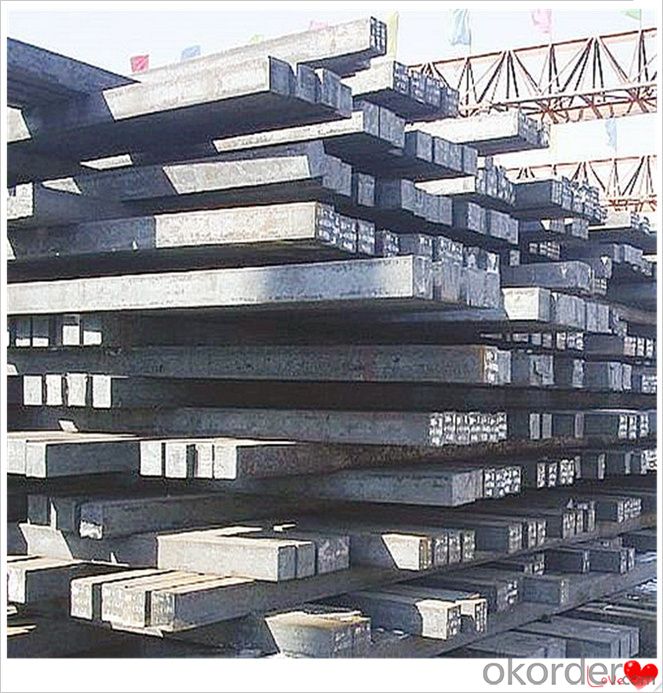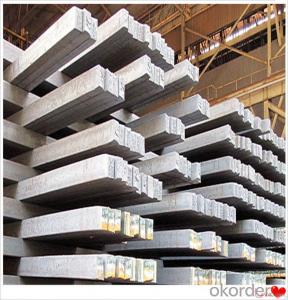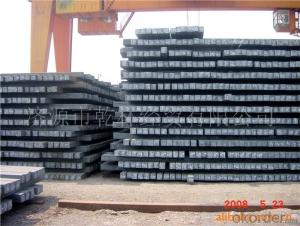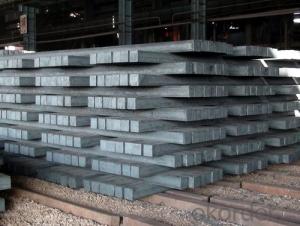Mild Steel Billet Q235,Q255,Q275,Q345,3SP,5SP,20MnSi Chinese Supplier
- Loading Port:
- China main port
- Payment Terms:
- TT OR LC
- Min Order Qty:
- 20 m.t.
- Supply Capability:
- 200000 m.t./month
OKorder Service Pledge
OKorder Financial Service
You Might Also Like
Mild Steel Billet Q235,Q255,Q275,Q345,3SP,5SP,20MnSi Chinese Supplier
Specification
Steel billet(ingot) by cogging or breakdown of semi-finished products, is the raw material of all kinds of steel mill. Billet section of square, round, flat, rectangular and abnormity of several kinds of, mainly related to the shape of rolled products.
CNBM Q235,Q275,Q345,3SP,5SP,20MnSi Billets Steel in Hot Sale
Hot Rolled Steel Billets/ Mild Steel Bar/ Billet Steel Prime Steel Billet
Specification (see below)
Standard: GB/JIS/ASTM
Size: 50*50mm-180*180mm
Length: 3-12mtrs or Customised
Steel material: Q235,Q255,Q275,Q345,3SP,5SP,20MnSi
Technique: Hot rolled
FOB Unit Ton Price $250-350 and Usually I will quote you CFR price.
MOQ: Usually 1000-10000MT/size
Shipment:By Container,Bulk Vessel
Packaging Details: bundles with steel strips or as customers's requirements
Delivery time: Usually within 30 days after the deposit/LC
Inspection:Third party inspection before loading.
Technical data

Feature Steel Billet
Rectangular billet continuous casting billet and mainly general carbon steel, low carbon low silicon cold-rolled material, high quality carbon structural steel, high strength low alloy steel, special steel, etc.
The billet is mainly divided into two kinds from the shape:
Slab: cross section width and height of the ratio of the larger, mainly used for rolling plate.
Billet: equal cross section width and height, or a huge difference, mainly used for rolling steel, wire rod. ,
Steel billets have distinct characteristics as compared with already furnished steel bars and products. Billets have a specific grain structure, which enables the metal to be processed more intricately. Steel billets are also known for their malleability and ductility, especially when exposed to varying temperatures during shaping and molding.
Packaging & Shipping
1. Packaging:
1) Small size: in bundles
2)Big size: in bulk
3)in plastic packing or as per customer requirement
2. Delivery time:
1) Normal size: within 7days send from warehouse directly
2) Special size: with 25-30days customer made for you
3. Trade terms:FOB/CFR/CIF
4. Shippment:
1) length:≤5.8m loaded in 20FT Container with 25-27tons
2) length:≤11.8m loaded in 40FT Container with 25-27tons
3) lengnth:≥12m shipped by bulk vessel, FILO terms
Steel Billet Images






Processing

Usage-Billet Steel
Used for the plant, the bridge,shipment building high-rise building construction,lifting and transportation machinery, equipment manufracturing base building the support foundation pile manufacturing.
Billets, or ingots (as they sometimes referred to), are not of practical use until they have been formed into more functional shapes and sizes. While they have already been put in the furnace, they still require a series of shaping and molding procedures such as hot and cold working, milling and cutting before they are sold in hardware stores, or used for different applications. The unformed billets, however, can be used in striking currency such as coins and as reserves, similar to gold bars.
FAQ-Billet Steel
We have organized several common questions for our clients,may help you sincerely:
1) How about your company?
A world class manufacturer & supplier of castings forging in carbon steel and alloy steel,is one of the large-scale professional investment casting production bases in China,consisting of both casting foundry forging and machining factory. Annually more than 8000 tons Precision casting and forging parts are exported to markets in Europe,America and Japan. OEM casting and forging service available according to customer’s requirements.
2) How to guarantee the quality of the products?
We have established the international advanced quality management system,every link from raw material to final product we have strict quality test;We resolutely put an end to unqualified products flowing into the market. At the same time, we will provide necessary follow-up service assurance.
3) How long can we receive the product after purchase?
In the purchase of product within three working days, We will arrange the factory delivery as soon as possible. The pecific time of receiving is related to the state and position of customers.Commonly 7 to 10 working days can be served.
4)Do you have your own QC department?
Yes, we have, our QC department will inspect the goods during the process of mass production and after completion of production.
hot sale!!! Cast Steel Grades/ mild steel bar/ billet steel
(1): High quality steel with reasonable price.
(2): Wide excellent experiences with after-sale service.
(3): Every process will be checked by responsible QC which insures every product's quality.
(4): Professional packing teams which keep every packing safely.
(5): Trial order can be done in one week.
(6): Samples can be provided as your requirements.
- Q: How are steel billets used in the manufacturing of tools and equipment?
- Steel billets are used in the manufacturing of tools and equipment as they serve as the raw material for shaping and forming various metal products. These billets are heated, forged, and machined to create different components such as shafts, gears, fasteners, and cutting tools. The high strength and durability of steel make it an ideal choice for manufacturing tools and equipment that require strength, precision, and resistance to wear and tear.
- Q: How are steel billets used in the production of railway wheels?
- Steel billets are used in the production of railway wheels by being heated and then forged into the desired shape. This process helps to create a strong and durable wheel that is capable of withstanding the heavy loads and constant use in railway systems.
- Q: How are steel billets unloaded at the destination?
- Steel billets are typically unloaded at the destination using heavy machinery such as cranes or forklifts. These machines carefully lift and transport the steel billets from the transport vehicle to the designated storage area.
- Q: What are the main factors affecting the fatigue strength of stainless steel billets?
- The main factors affecting the fatigue strength of stainless steel billets include the composition and microstructure of the steel, the presence of surface defects or imperfections, the level of applied stress or load, the presence of corrosive environments, and the temperature at which the billets are operating.
- Q: What are the main challenges in the distribution of steel billets?
- The overall efficiency and effectiveness of the steel billet distribution process can be impacted by several challenges. These challenges include: 1. Logistics and transportation pose a difficulty due to the weight and size of steel billets. Specialized equipment and handling are necessary, making transportation challenging, particularly in remote areas or regions with poor infrastructure. Coordinating transportation modes, scheduling, and ensuring timely delivery adds complexity to the task. 2. Storage and inventory management present challenges as steel billets often need to be stored before further distribution or processing. Proper storage facilities with adequate capacity and suitable conditions, such as temperature control and protection from moisture, are crucial. Managing inventory levels to avoid excess or shortage is also a key challenge. 3. Quality control is essential to maintain the quality of steel billets throughout the distribution process. Any damage or contamination during handling or transportation can affect the final steel products' properties and performance. Implementing strict quality control measures, inspections, and monitoring processes is crucial to meet desired quality standards. 4. Market fluctuations and demand forecasting are challenging due to factors like economic conditions, construction activities, and geopolitical events. Accurate demand forecasting is crucial, as failure to predict demand accurately can lead to excess inventory or stockouts, resulting in financial losses. 5. Environmental regulations and sustainability requirements impose challenges. Compliance with environmental regulations, such as emissions control and waste management, can be challenging in the distribution process. Utilizing eco-friendly transportation methods and exploring sustainable packaging options can help address these challenges. 6. Global competition and pricing pressures affect steel billet distribution. Constant analysis and adaptation to market trends, competitor behavior, and price fluctuations are necessary for steel producers and distributors. Maintaining competitive pricing while ensuring profitability is a significant challenge in the steel billet distribution business. To overcome these challenges, coordination among various stakeholders in the supply chain is essential. This includes steel manufacturers, distributors, logistics providers, and end-users. Continuous improvement, technological advancements, and effective communication are crucial to mitigate these challenges and optimize the distribution of steel billets.
- Q: What are the different grades of steel used for making billets?
- There are several different grades of steel that are commonly used for making billets. The specific grade of steel used depends on the intended application and the desired properties of the billet. One commonly used grade of steel for making billets is carbon steel. Carbon steel is a versatile and relatively inexpensive option that offers good strength and hardness. It is often used in applications where high strength is required, such as in the construction industry. Another grade of steel commonly used for billet production is alloy steel. Alloy steel is made by adding various alloying elements to carbon steel, such as chromium, nickel, or molybdenum. This results in improved strength, toughness, and corrosion resistance, making alloy steel suitable for a wide range of applications including automotive parts, machinery components, and tooling. Stainless steel is another grade of steel that is often used for making billets. Stainless steel contains a minimum of 10.5% chromium, which provides excellent corrosion resistance. It is commonly used in industries requiring resistance to oxidation and corrosion, such as the food and beverage industry, medical equipment manufacturing, and architectural applications. Additionally, there are specialized grades of steel used for specific applications. For example, high-speed steel (HSS) is used for making billets used in cutting tools, as it offers exceptional hardness and heat resistance. Tool steel is another specialized grade used for making billets for tools and dies, offering high hardness, wear resistance, and toughness. In summary, the different grades of steel used for making billets include carbon steel, alloy steel, stainless steel, high-speed steel, and tool steel. The choice of grade depends on the specific requirements of the application, such as strength, toughness, corrosion resistance, or specialized properties needed for cutting tools or tooling.
- Q: Are steel billets used in the production of electrical transmission towers?
- Yes, steel billets are commonly used in the production of electrical transmission towers. Steel billets are the initial form of the steel used in the manufacturing process. They are typically hot rolled into various shapes and sizes, including the sections and components necessary for constructing transmission towers. The high strength and durability of steel makes it an ideal material for these structures, as they need to withstand harsh environmental conditions and support heavy electrical conductors. Furthermore, steel offers excellent electrical conductivity properties, which is crucial for the efficient transmission of electricity through the towers. Overall, steel billets play a crucial role in the production of electrical transmission towers, ensuring the strength, durability, and efficiency of these structures.
- Q: What are the different types of cutting methods used for steel billets?
- There are several different types of cutting methods used for steel billets, including sawing, shearing, flame cutting, and water jet cutting.
- Q: What are the main challenges in manufacturing steel billets?
- The main challenges in manufacturing steel billets include ensuring consistent quality and uniformity, managing the high temperatures involved in the process, maintaining efficient production rates, minimizing material waste, and addressing environmental concerns related to energy consumption and emissions. Additionally, ensuring the safety of workers and implementing effective maintenance practices are important challenges in the manufacturing of steel billets.
- Q: How are steel billets inspected for dimensional accuracy?
- Steel billets are inspected for dimensional accuracy through a series of rigorous processes to ensure that they meet the required specifications. These inspections are crucial as any deviations in the dimensions can have a significant impact on the final product's quality and performance. Firstly, steel billets are visually inspected to identify any surface defects or irregularities. This includes checking for cracks, surface oxidation, or any other visible abnormalities that could affect the dimensions. This visual inspection is often conducted by trained personnel who have an eye for detail and can identify even the smallest imperfections. After the visual inspection, the billets undergo dimensional measurement using various tools and instruments. One commonly used tool is a caliper, which is used to measure the length, width, and height of the billet. The measurements are compared against the specified dimensions to ensure they fall within the acceptable range. Any deviations beyond the tolerance limit are flagged for further investigation. In addition to calipers, other tools such as micrometers, height gauges, and coordinate measuring machines (CMM) may also be used to measure specific dimensions or features of the billet. These instruments provide more accurate and precise measurements, especially for critical dimensions that require a higher level of precision. Furthermore, non-destructive testing techniques are employed to assess the internal quality and dimensional accuracy of the billets. Ultrasonic testing, for instance, uses high-frequency sound waves to detect any internal defects or inconsistencies that may affect the dimensions. This method can identify hidden flaws such as voids, inclusions, or discontinuities, providing a comprehensive assessment of the billet's dimensional accuracy. Overall, steel billets are inspected for dimensional accuracy through a combination of visual inspections, dimensional measurements using various tools, and non-destructive testing techniques. By conducting these inspections, manufacturers ensure that the billets meet the required specifications, leading to high-quality final products.
Send your message to us
Mild Steel Billet Q235,Q255,Q275,Q345,3SP,5SP,20MnSi Chinese Supplier
- Loading Port:
- China main port
- Payment Terms:
- TT OR LC
- Min Order Qty:
- 20 m.t.
- Supply Capability:
- 200000 m.t./month
OKorder Service Pledge
OKorder Financial Service
Similar products
Hot products
Hot Searches
Related keywords































